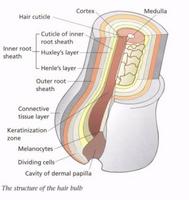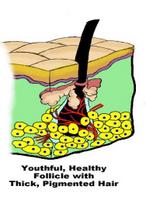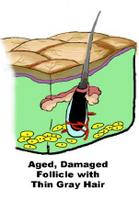What causes hair to turn gray?
 There are quite a few things that are guaranteed in life and one of such things is going gray. It may be hard to imagine, if you have not yet started to gray, that someday your lovely hair will change its color to gray, shades of gray or even white. Gray hair can make anyone look older than they actually are and so, it is most times a unwelcome transformation. Due to this however, there are several different types of commercial products such as hair dye out there on the market to remedy this problem, allowing individuals to look younger. It is also important to note here that there are people that look very lovely with their hair being gray and therefore choose to have it remain that way. Gray hair is usually a sign of aging and maturity however, there are other factors ( which will be looked at) that causes our hair to become gray such as vitamin B12 deficiency and our genetic makeup.
There are quite a few things that are guaranteed in life and one of such things is going gray. It may be hard to imagine, if you have not yet started to gray, that someday your lovely hair will change its color to gray, shades of gray or even white. Gray hair can make anyone look older than they actually are and so, it is most times a unwelcome transformation. Due to this however, there are several different types of commercial products such as hair dye out there on the market to remedy this problem, allowing individuals to look younger. It is also important to note here that there are people that look very lovely with their hair being gray and therefore choose to have it remain that way. Gray hair is usually a sign of aging and maturity however, there are other factors ( which will be looked at) that causes our hair to become gray such as vitamin B12 deficiency and our genetic makeup.  As a result of this, it is possible that we can be very young and start showing visible signs of gray hair - here and there. There are some individuals in their twenty’s and surprisingly teenagers also, who are dealing with this transformation of their hair being gray! This means therefore, whatever the stage of your life you may be at, it is possible for someone to start graying.
As a result of this, it is possible that we can be very young and start showing visible signs of gray hair - here and there. There are some individuals in their twenty’s and surprisingly teenagers also, who are dealing with this transformation of their hair being gray! This means therefore, whatever the stage of your life you may be at, it is possible for someone to start graying.
Before the question above is answered, first it is important that we take a quick look at the structure of the hair below:
Click on image to enlarge


Using the diagrams as a guide, we can see that the strand of hair in the dermis originates in a deep pouch-like depression (sac) of the epidermis which completely surrounded by a tube of tissue called the hair follicle (fah-lih-kul). Hair follicle is lined by cells derived from the epidermal (outside) layer of the skin and it is divided into two segments: the lower segment consisting of the hair bulb and the upper segment consisting of the mid-follicle. Hair structure therefore consist of the bulb, mid follicle and the shaft. The hair shaft is the part of the hair that can be seen above the skin, in this case the scalp. It is made up of mainly dead cells that have turned into keratins (a tough hair protein). In the hair bulb, there are special cells called melanocytes. These cells are responsible for continuously producing the pigment called melanin (meh-luh-nin). There are two types of melanin: eumelanin, which is dark brown or black, and pheomelanin, which is reddish yellow. These pigment give the human skin as well as our hair its natural color. These colors for our hair can be black, brown, blonde, red, and other spectrum of colors in between. Inside the follicle at the base of the hair, new hair cells develop by cell division which multiply and increase the cells in numbers. As new cells form, from cell division, they push the older cells out of the follicle (developing hair) in an upward direction carrying the pigment melanin in the inner part of the hair . As they are continued pushed out through the scalp (or skin), the cells die and become the hair we see. The same process happen for all hair that grows on our body and head (scalp) - each grows from its own individual hair follicle.
Now, what causes hair to turn gray? Well, there are more than one factors that cause our hair to become gray. Here we will look at some of them.
1. Reduction in melanocytes
As we get older the melanocytes that produce the color pigment melanin in our hair follicles gradually die and become much fewer in numbers. When this happens, that strand of hair will gradually loose its original color due to the lesser number of melanin present. As this continues the hair can change from gray , shades of gray, silver or white - if all melanocytes are absent.
2. Genes Genes (short pieces of DNA) are units of information inside the cells of our body. This information is passed on from parents to their offspring and is responsible for development of particular characteristics (traits) that make up the blueprint for the human body and its functions.
Genes (short pieces of DNA) are units of information inside the cells of our body. This information is passed on from parents to their offspring and is responsible for development of particular characteristics (traits) that make up the blueprint for the human body and its functions.
Earlier it was mentioned that there are individuals who start to gray at an early age such as in their teenage years and 20’s while others might start in their 30’s, 40s, 50s and even in their 60s. Why does this happen? It is caused by the genes that we inherent from our parents. If your parents started to gray at an early age for example in their 20s then chances are very high that you will likely start to gray around that exact time.
3. Vitamin B-12 deficiency
Vitamin B12 is needed to produce an adequate amount of healthy red blood cells in the bone marrow. In young children, a deficiency in vitamin B-12 (cobalamin) can cause the graying of hair. Even though this dietary deficiency is difficult to achieve today, due to its wide availability in food such as animal meat and their products, it is possible to suffer from this deficiency disease especially, those individuals who are on strict vegan diet. Thus, a lack of this vitamin in the body can lead to a form of anemia called megaloblastic anemia, which causes premature graying.
Even though this dietary deficiency is difficult to achieve today, due to its wide availability in food such as animal meat and their products, it is possible to suffer from this deficiency disease especially, those individuals who are on strict vegan diet. Thus, a lack of this vitamin in the body can lead to a form of anemia called megaloblastic anemia, which causes premature graying.
Other causes of this deficiency disease are: the body’s inability to absorb this vitamin due to stomach or small bowel surgery, infants who are breast fed by mothers who have B12 deficiency can develop a transient deficiency, diseases affecting the small bowel (e.g. tuberculosis and fish tapeworms) and a congenital lack of the molecules needed to absorb B12 ( intrinsic factor and Transcobalamin I, II, or III) by the body.
4. Smoking
A 1996 British Medical Journal study reported that smokers are four times more likely to go gray at a young age. According to J. G. Mosley of the Leigh Infirmary in Lancashire, England - in an article in Science News (January 11, 1997) - provided data that smokers are four times more likely to have gray hair (prematurely) than nonsmokers. Evidence conclusively have shown also that smoking is linked to accelerated hair loss. This was found to do with blood vessel constriction caused from the chemical (nicotine) absorption.
5. Other causes of gray hair
Thyroid imbalance,
CAD (coronary artery disease),
Children with deficient immune systems (HIV, AIDS, leukemia, chemotherapy, radiation). Graying of the hair might not start at one go for the entire hair since, each hair on your body grows from its own individual hair follicle that produce melanin. The remaining dark hair will remain in the resting phase, while the new hair coming up are gray. After a given period of time, the remaining dark hair will eventually come off, leaving only the gray hair. This can take up to 10 years or more for all of the hair to turn gray. Graying individuals with darker hair are also more noticeable than people with naturally lighter hair.
Graying of the hair might not start at one go for the entire hair since, each hair on your body grows from its own individual hair follicle that produce melanin. The remaining dark hair will remain in the resting phase, while the new hair coming up are gray. After a given period of time, the remaining dark hair will eventually come off, leaving only the gray hair. This can take up to 10 years or more for all of the hair to turn gray. Graying individuals with darker hair are also more noticeable than people with naturally lighter hair. Did you know?
Did you know?
Some facts about hair:
Humor on age and gray hair
==============================
Gray hair is a sign of age, not wisdom.
- Greek proverb
The glory of young men is their strength, gray hair the splendor of the old.
Proverbs 20:29 By common consent gray hairs are a crown of glory; the only object of respect that can never excite envy.
By common consent gray hairs are a crown of glory; the only object of respect that can never excite envy.
~George Bancroft~
"Will you love me in December as you do in May,
Will you love me in the good old fashioned way?
When my hair has all turned gray,
Will you kiss me then and say,
That you love me in December as you do in May?"
~ James Walker~
Related Articles:
How Rainbows Are Formed - What Causes a Rainbow?
The Meaning of Colors - Color Symbolism
Why are traffic lights Red, Yellow and Green?
Why leaves change color in fall?
Why do people have different colors of skin?
Why is the sky blue?





 R. Edmondson
United States
R. Edmondson
United States












































13 Comments:
what a great post! thanks for the info.
Nice Blog!
But what do u have against IE?
Keep BLOGging!!
Visit my blogs Sometime...
http://prahalathan.blogspot.com/
http://prahalspics.blogspot.com/
interesting post not very encouraging for me. I started turning grey when I was 18. Still got some black though.
Great research. When my first few strands of gray hair appeared, I would pull them off whenever I see them. However, the gray hairs seemed to grow faster than I can pull them out! So, after a while,I stopped doing that...I reckon that it's better to have gray hair than no hair at all.
Thanks for yet another good post.
WOW, gripping stuff!
Neat post :)
I'm a natural redhead and I think that redheads have less hairs than blondes and brunettes. I began to have my first gray's about a year ago, just in time I turned 40. Today it's almost white around my ears and I look like a fox who's been playing with bleach ;)
It doesn't bother me much though...in the opposite it belongs to aging and adds something :)
As a 26 yr old who is finding quite a crop of gray I loved reading your article. Thank you for the insight.
Saying "Hi" on every blog I hit through blog explosion today. So Hi!
Thank you guys very much for your comments. I can't thank you guys individully but, i will be seeing each one of you at your blog :)
Thanks again.
i'm 21 and my hair is turning white. i'm a vegetarian,maybe i need more nutrients or b12.thanks for the insight.
I am going to answer one simple question that might have answered by many but solution given by none. The question is" How to remove gray hair?" I know most of people are not aware of the answer. Reparex , yes you heard it right. It is one of the best product that i have used for gray hair reversal.
However, there are some best practices following which a person can save his or her precious hair. Treatment Options for Early Signs of Balding
Post a Comment
<< Home